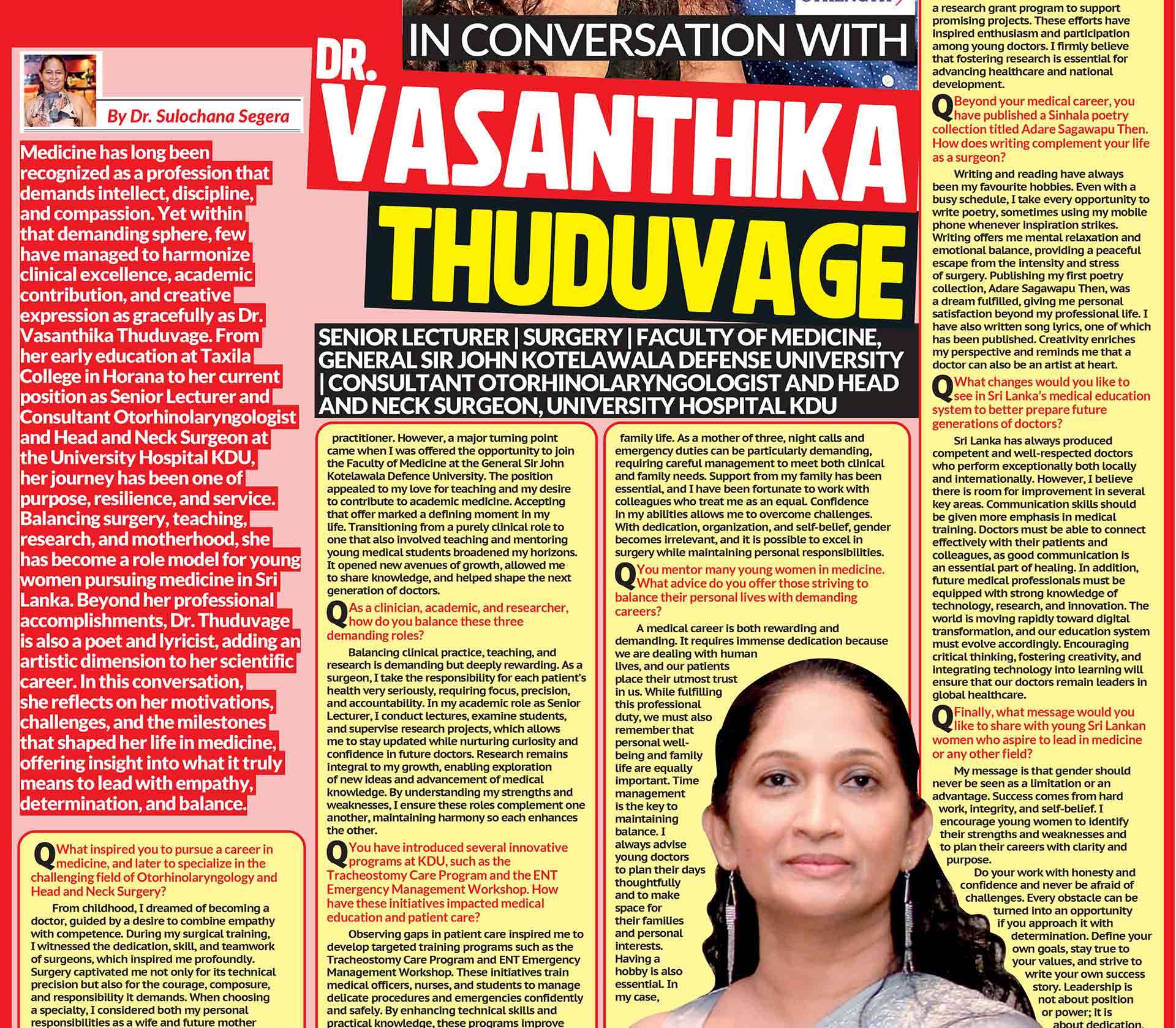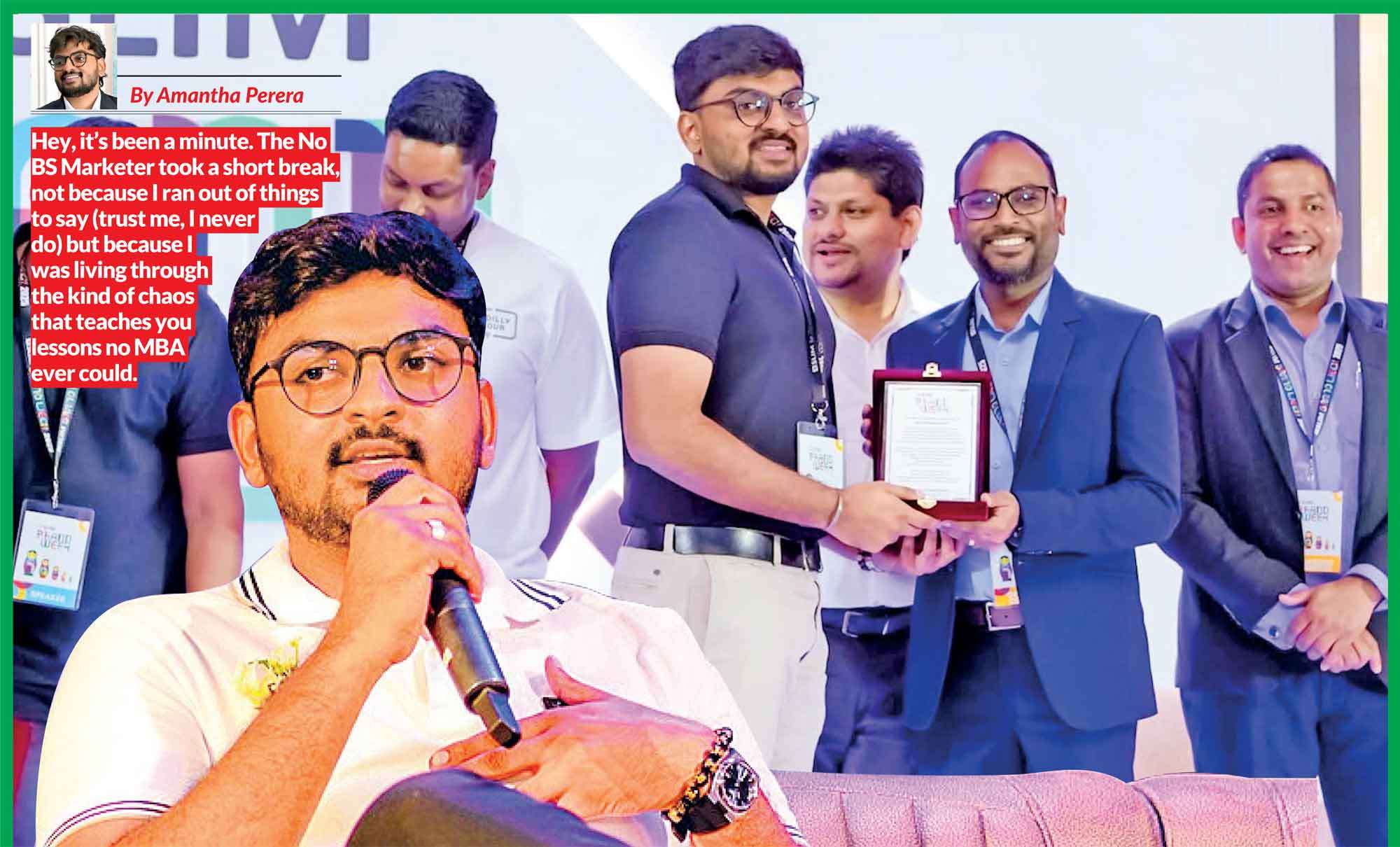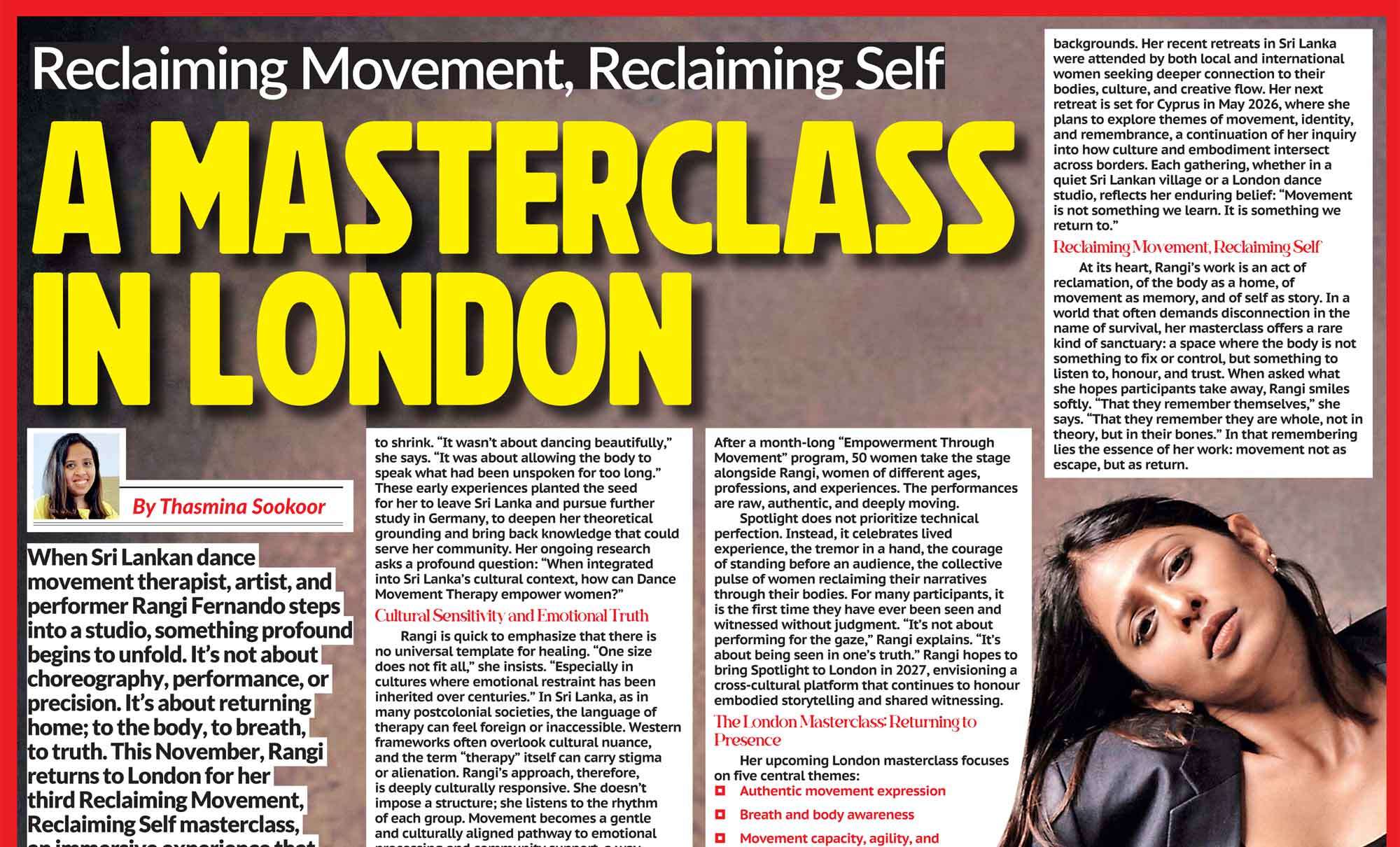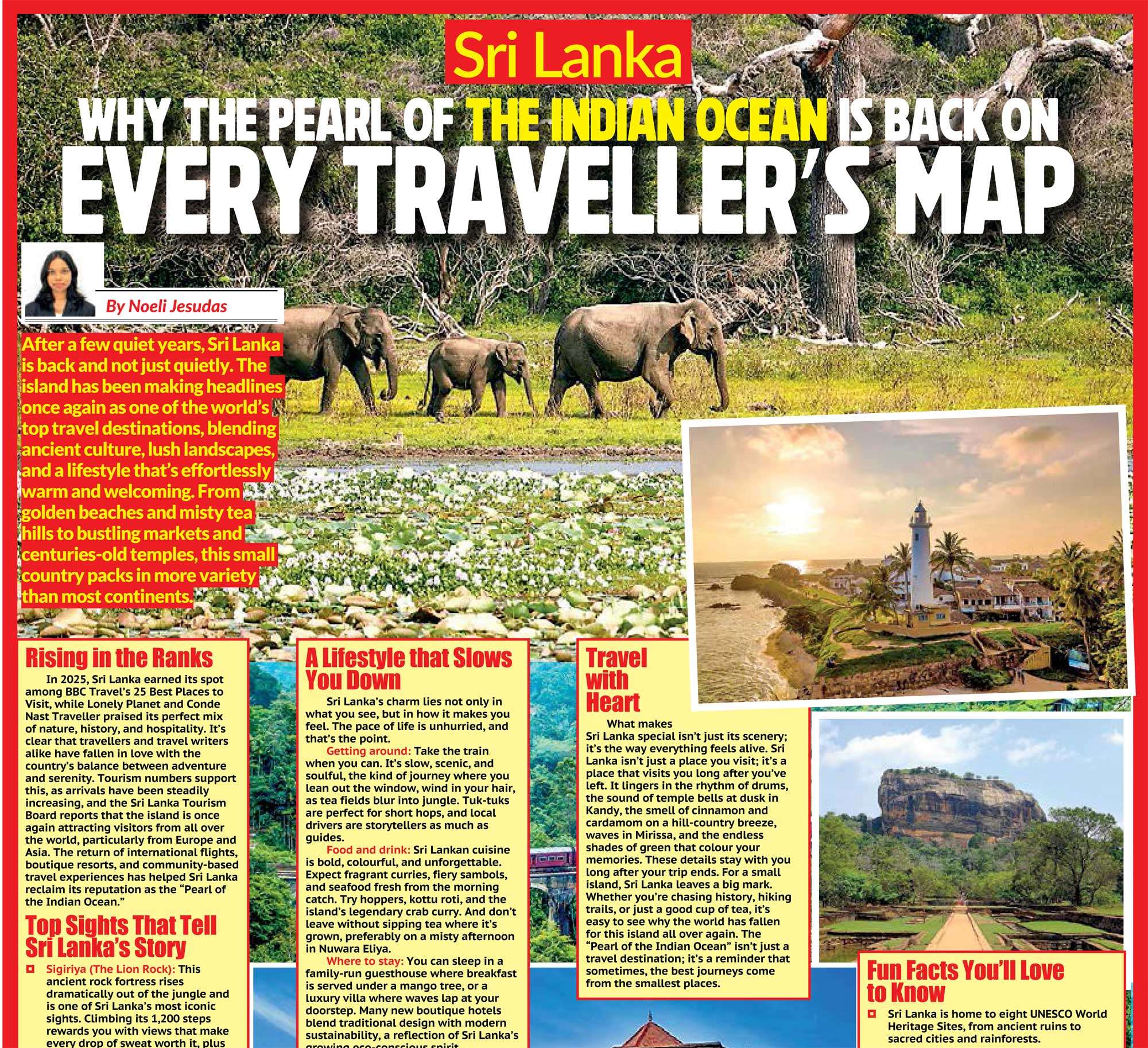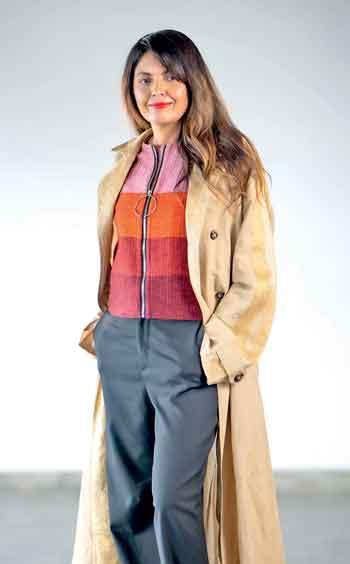 Linda Speldewinde stands as one of Sri Lanka’s most inspiring figures; a visionary entrepreneur, creative leader, and fierce advocate for women’s empowerment. As the Founder of the Academy of Design (AOD), Mercedes-Benz Fashion Week Sri Lanka (MBFWSL), and the Sri Lanka Design Festival (SLDF), she has transformed the island’s creative landscape, redefining its global identity through design, fashion, and innovation. Her journey is one of audacity and purpose, one that has inspired countless girls and women across the country to dream beyond boundaries.
Linda Speldewinde stands as one of Sri Lanka’s most inspiring figures; a visionary entrepreneur, creative leader, and fierce advocate for women’s empowerment. As the Founder of the Academy of Design (AOD), Mercedes-Benz Fashion Week Sri Lanka (MBFWSL), and the Sri Lanka Design Festival (SLDF), she has transformed the island’s creative landscape, redefining its global identity through design, fashion, and innovation. Her journey is one of audacity and purpose, one that has inspired countless girls and women across the country to dream beyond boundaries.
Within her organizations, Linda has consistently built female-led teams, nurturing generations of women leaders who now drive Sri Lanka’s creative economy. Her belief is simple yet profound: empower women and youth, and you empower a nation. In this exclusive conversation, Linda reflects on her vision, her role as a trailblazer, and how Sri Lanka’s design story continues to evolve; with women and youth leading the way.
QEvery year, MBFWSL evolves, but the 2025 edition feels particularly global. What’s new this year, and what story do you hope it tells about Sri Lanka to the world?
This year is about shifting the world’s gaze. Mercedes-Benz Fashion Week Sri Lanka 2025 positions our island not just as a manufacturing hub but as a creative author; a place where history, ideas, and innovation intersect. Over the years, we’ve expanded to include cross-South Asian design collaborations and international voices. The message we’re sending is clear: Sri Lanka isn’t emerging anymore; we are here. We are contemporary, relevant, and redefining what it means to be a design nation.
QWhen you first envisioned Mercedes-Benz Fashion Week Sri Lanka, what was
your dream, and how close are we now to realizing it?
My dream was to prove that Colombo could stand as a global creative capital, the hub of South Asian design. We built MBFWSL to showcase a new aesthetic that is distinctly ours. Today, that dream is materializing. Our designers are exporting internationally, our alumni are leading creative studios worldwide, and we’ve transformed from being viewed as a “manufacturing base” to a design origin point. Sri Lanka’s creative voice is now heard on catwalks from New York to Paris to Tokyo, rooted in craftsmanship yet globally fluent. The dream continues, shaping a regional identity the world can recognize and celebrate.
QFashion is often perceived as fleeting, but your approach treats it as part of an economic and cultural infrastructure. How do you balance artistry with the systems that sustain it?
Fashion, to me, is a system. Artistry is its soul; but industry is its engine. We design the ecosystem first: education, artisan networks, supply chains, markets, and access points. At AOD, our degree programs integrate these components, ensuring students engage with both creative vision and real-world industry collaboration. This holistic model gives creativity room to breathe and expand, because it is supported, not isolated. That’s why our graduates and designers thrive: they’re connected to both heritage and innovation.
QThe term “The New Local” has become central to your philosophy. How has it evolved in 2025?
“The New Local” today means being rooted but globally fluent. It’s not about isolation; it’s about expression. It’s understanding who we are and expressing it in ways that connect with the world. Our collaboration with artisans has been key to this, students learn from masters of traditional crafts, keeping heritage alive while embedding sustainable, human-scale production into the modern design process. It’s local thinking with global impact.
QThe Academy of Design has been the cradle of Sri Lanka’s design movement. How has its role evolved now that many of your alumni lead their own brands and studios?
This is perhaps the most rewarding phase for me. Our alumni are now leading conversations, from fashion to interior design, from visual communications to animation. AOD’s role has evolved from pioneering to enabling; we open doors, create networks, and give our graduates the confidence to scale their visions globally. The movement we once started is now being led by many, and that’s precisely the legacy we wanted.
QWhat new directions are you seeing from AOD’s next generation of designers in how they interpret Sri Lankan identity today?
The new generation is remarkably self-aware. They draw deeply from local experience but align with global values; sustainability, purpose, and meaning. They are exploring regenerative design, material innovation, and technology that complements craft. They’re progressive yet authentic, redefining Sri Lankan identity in subtle, intelligent ways.
QCraft is central to your philosophy, yet you frame it as culture, not nostalgia. How do you keep traditional craftsmanship relevant to Gen Z consumers?
Gen Z demands authenticity and connection. When craft is presented as living culture, not a relic, it resonates deeply. We co-create with artisans, integrating new materials, forms, and technologies. Every product tells a story of maker, process, and place. By making that story visible and contemporary, craft becomes both relevant and aspirational.
QSri Lanka’s apparel industry has long been known for manufacturing. How does MBFWSL reframe that narrative toward innovation and creativity?
By showing, not telling. MBFWSL curates design at international standards, backed by strong design education and industry partnerships. When creativity meets manufacturing excellence, perception shifts naturally. Sri Lanka’s strength in production becomes our foundation; creativity is what builds
upon it.
QThis year’s Sri Lanka Design Festival celebrates regional collaboration with India as a partner nation. What excites you most about this South Asian design dialogue?
The global lens is turning toward South Asia. We share deep histories of craftsmanship and design yet express them differently. With India as our partner nation and participants from Bangladesh and Bhutan, we’re shaping a collective South Asian identity. It’s about showing the world that design here is contemporary, innovative, and unapologetically ours.
QYou divide your time between Colombo and Toronto through Urban Island. How has this duality shaped your vision?
Toronto helped me see Sri Lanka more clearly. Its cultural diversity emphasized our strengths, our warmth, craftsmanship, and natural aesthetic. Colombo grounds me; Toronto broadens me. Urban Island was born at that intersection, taking Sri Lankan craft to the world while bringing global understanding home.
QUrban Island’s Rosedale store in Toronto is seen as an experience, not just retail. How have Canadians responded to Sri Lankan slow design?
With genuine curiosity and admiration. They are drawn to the authenticity; handwoven textiles, natural materials, and intentional living. Urban Island isn’t about selling products; it’s about sharing a philosophy of warmth, simplicity, and meaning. That resonates deeply in a world craving authenticity.
QYou’ve built an entire ecosystem, from AOD to MBFWSL, SLDF, and Urban Island. Was that intentional or organic?
Both. Each initiative was created in response to a need. Education came first through AOD. Then we needed a platform, Fashion Week. Then a festival, SLDF. Then markets, Urban Island. It was always about creating pathways for designers to thrive, not just earn a degree. Purpose built the ecosystem.
QWhat global misconceptions about Sri Lankan creativity would you like to correct?
That we are “small.” Yes, our scale is small, but that’s our strength. We’re agile, connected, and imaginative. Our ideas are vast, our stories are rich, and our creativity transcends scale. Smallness can be powerful, it allows for intimacy, authenticity, and impact.
QLooking ahead, what’s the dream you haven’t yet realized?
To see a distinct South Asian aesthetic, rooted in our shared craftsmanship and contemporary design, recognized globally as a unified creative language. That’s the dream I’m still building toward.
QAOD has always emphasized academic rigor while preparing students for real-world entrepreneurship. How do you sustain that balance today?
It’s challenging, especially in a fast-changing world. But our mission remains clear: to produce designers who are thinkers, not just doers. The biggest disruptor now is AI, and we’re teaching students to use it as a tool, not a replacement for human insight. At the same time, we protect artisanal knowledge and emphasize slow, thoughtful creation. It’s about balance, technology and tradition working in harmony.
QYou often speak of “low-tech meets high-tech.” How does that philosophy play out today?
Craft gives us identity; technology gives us reach. We blend the two, using digital tools to amplify handmade stories. Partnerships with industry keep us at the cutting edge, but our foundation remains human-cantered. Technology supports creativity; it doesn’t define it.
QSustainability has been part of your mission long before it became a global buzzword. How do you keep it meaningful, not tokenistic?
For us, sustainability is designed into every process. From sourcing materials to working with local communities, it’s embedded in how we operate. It’s not a checkbox; it’s a mindset. The Sri Lankan industry’s increasing commitment to sustainability helps amplify this shared purpose.
QThe Sri Lanka Design Festival has often been described as a “living classroom.” What do you hope emerges from this year’s festival?
Every year, SLDF sparks new collaborations and inspiration. This year, the most exciting outcome would be cross-South Asian designer collaborations that last beyond the festival, building relationships and creative exchanges that define our regional voice. Each edition brings us closer to establishing that signature South Asian aesthetic.
QYou lead an entire creative ecosystem that links education, commerce, and global engagement. What’s the glue that holds it all together?
Purpose. It’s what connects every part of what we do. The belief that design can shape economies, culture, and identity, that’s the thread that binds everything. When you lead with purpose, everything else aligns naturally.
QFinally, if you could define Sri Lankan design in one phrase for the world in 2025, what would it be?
Purpose and impact in a world in transition.


